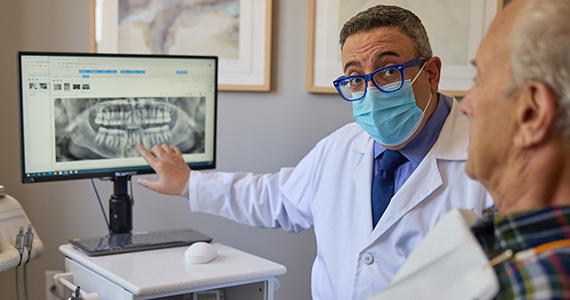Dental X-rays: Types and Uses
Learn about the different types of X-rays.

The Importance of Diagnostic Imaging
X-rays are a very important part of your dental exam. X-rays can show your dentist not only where there may be cavities, but the condition of your teeth and bone that are hidden below the gum line. There are several kinds of X-rays that dentists take for different reasons.
X-rays and Insurance
X-rays fall under the diagnostic category of your insurance benefits. These benefits have limitations that involve both the type of X-ray and the frequency.
If you decide to switch dental offices, you may need to request that your X-rays be transferred to the new office. This will ensure the new office has all of the images they need without having to re-do them and risk the service not being covered due to frequency or timing limitations. This can help reduce potential out-of-pocket expenses and minimize radiation exposure.
Comprehensive and Panoramic X-rays
Have you ever sat in a dental chair with your mouth opened while countless films or digital sensors went in and out of your mouth? This X-ray process captures images of the whole mouth. The images show all of the teeth in their entirety above and below the gums. Plus, it shows the surrounding bone, areas where no teeth may be present, and other structures. This is called an intraoral comprehensive series, or full mouth X-rays (FMX), and is a combination of numerous periapical and bitewing images. The full mouth X-ray series is generally taken at your first visit as a new patient. This allows your dentist to examine structures they can't see during a visual inspection, design a treatment plan specifically for you or determine if you should be referred to a specialist.
If you have stood with an X-ray machine circling your head, you have had a panoramic X-ray. This is a scan of your entire mouth that produces a single large image. It is a panoramic image that shows the upper and lower teeth and supporting bone, jaw joints, nerves and sinuses. New panoramic images are usually taken every 3-5 years.
A dentist may order a panoramic or comprehensive series of X-rays depending on your age, concerns, dental history, diagnosis or scope of treatment plan.
Periapical X-ray
A periapical X-ray is used to capture the anatomy of an entire tooth beyond what the naked eye can see. This includes the crown (above the gum line), gum line, the tooth root and the bone surrounding a single tooth. Your dentist may take a single X-ray under these circumstances:
- Toothache — To see if there is infection present or a hairline crack that only an X-ray can reveal.
- Extraction — To see if there is any remaining tooth structure left after a complicated procedure to ensure all pieces of the tooth have been removed.
- Root canal procedure — To ensure the tooth has been sealed to the root tip.
- Crown procedure — To see the fit and position of your new crown.
Bitewing X-rays
Bitewing X-rays are also known as cavity-detecting X-rays. These X-rays show cavities in between your teeth and changes in bone level, which may be impacted by gum disease. Bitewing X-rays are typically taken at a routine checkup appointment. They usually consist of two or four images that allow the dentist to view all the teeth located in the back of the mouth.
Occlusal X-ray
An occlusal X-ray is similar to a periapical X-ray, or panoramic X-ray, where only one film is used. However, an occlusal X-ray is typically used in pediatric dentistry. It captures an image of the full arch, which means all of the upper teeth (upper arch), or all of the lower teeth (lower arch). When you bring your child to their first visit, your child's dentist may take an occlusal X-ray of each of their arches to determine:
- If there are any cavities present on the front teeth.
- If the adult teeth are present.
- The position of the adult teeth.
- If there are extra teeth present behind the baby teeth.
Reduce Gagging During X-rays
While technology has allowed X-rays to be acquired quickly and digitally, it does not free you from getting the film or a sensor physically placed in your mouth. If you experience gagging while having these placed in your mouth, try closing your eyes and breathing slowly and deeply through your nose.
Note: The information in this document is not meant to replace the advice of your dentist or another licensed healthcare professional. Talk to your dentist for any specific dental advice.






